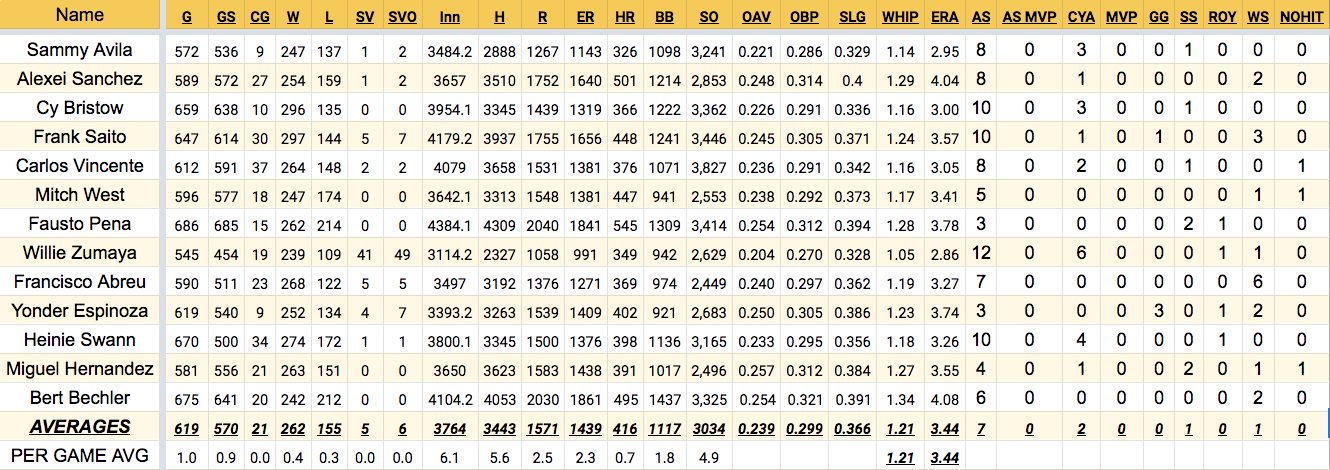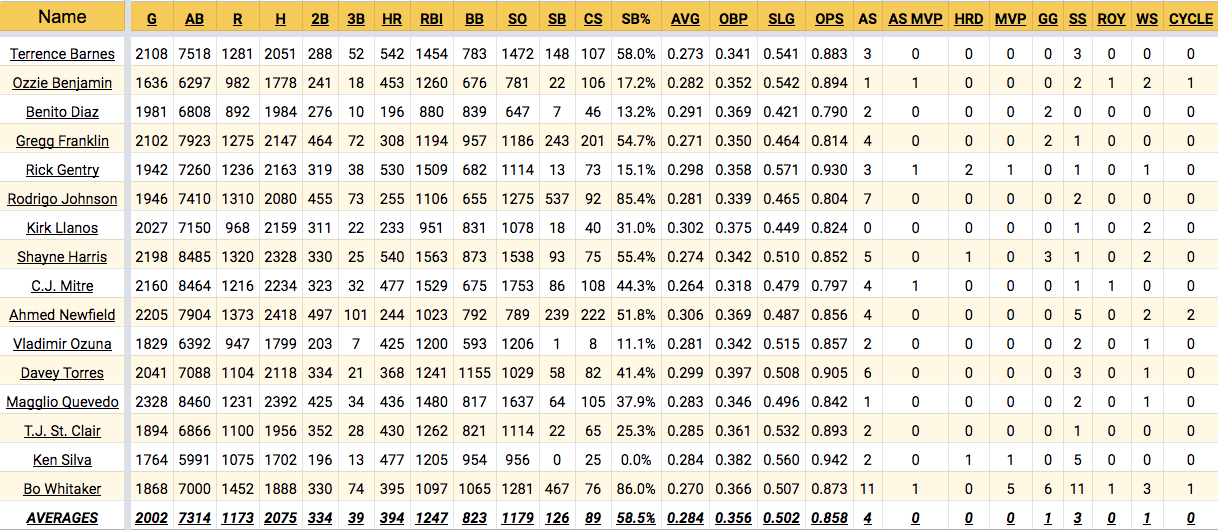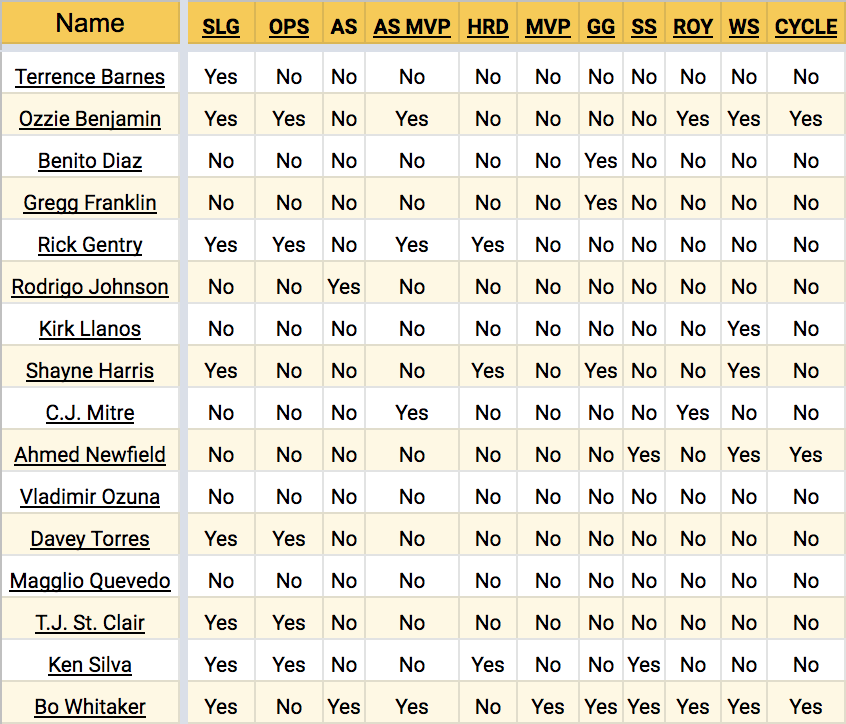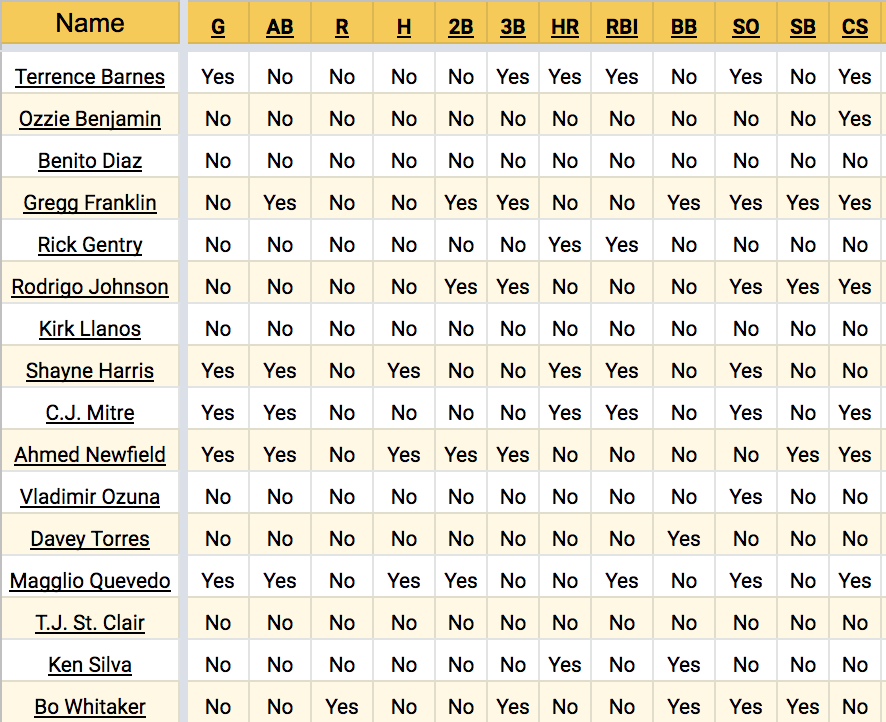As we make our decisions regarding Hall of Famers, here is some information about our current Hall of Famers, as well as our current nominees, that may help you fill out your ballot.
A. Current Hall of Famers and Statistics
Position Players

Starting Pitchers

Relief Pitchers

Hall of Fame Composite
Position Players
The average Hall of Fame position player was a heart of the order hitter, with 2,495 hits (+18, compared with Season 36, pre-Hall of Fame induction), 409 doubles (+3), 490 home runs (-10), 1,509 RBI (-14) and a 0.890 (-0.007) on base plus slugging (OPS, excluding hit by pitch or sacrifice data). Additionally, the average Hall of Fame position player made seven All Star appearances, won one MVP, one Gold Glove, four Silver Sluggers (-1), and won two World Series rings.
On a per game basis, the average Hall of Fame position player accrued 1.1 hits in 3.7 at bats, doubled and homered at roughly equivalent rates (0.2 each), scored and batted in 0.7 run, and walked 0.4 times compared with 0.5 strike outs.
Starting Pitchers
The average Hall of Fame starting pitcher demonstrated excellent control, winning 262 games (-2) and losing 155 (+5), collecting 3,034 strikeouts (+24) against just 1,117 walks (+26), and throwing to a 1.21 WHIP (+0.01) and 3.44 ERA (+0.06). The average SP made seven All Star appearances, won two Cy Young Awards, one Silver Slugger, and one World Series ring.
On a per game basis, the average Hall of Fame starting pitcher went six innings, allowed 5.6 hits (+0.1), 1.8 walks, and 2.3 earned runs while striking out 4.9.
Relief Pitchers
The average Hall of Fame relief pitcher was a reliable back-end bullpen arm, averaging 467 saves out of 548 opportunities (85.2%) in 989 total appearances. He allowed 1.19 baserunners per inning pitched and kept a 3.17 ERA. He averaged eight All Star appearances, three Fireman of the Year awards, and one World Series ring.
On a per game basis, the average Hall of Fame reliever pitched an inning and a third, allowed a hit, 0.4 walks and 0.4 earned runs, and struck out 0.9.
B. Hall of Fame Nominees and Statistics
Position Players

Starting Pitchers

Relief Pitchers

Comparison
Clearly, the averages for all three groups are significantly lower than our current group of Hall of Famers in virtually every category. However, several players rank as above average, compared with current Hall of Famers, in various categories, including some who would rank in the Top 5 of some categories if elected. Those will be outlined below.
In the meantime, it is important to remember that these are averages: some people fall above, and some people fall below, including current Hall of Famers. Simply falling below the average should not be the sole basis for exclusion. I encourage all owners to look at player holistically and vote on the merits.
Above Average Position Players
The tables below list each nominated position player and whether or not they were above average in a given category, when compared to current Hall of Famers, on both an absolute and per game basis.
Above Average When Compared with Hall of Famer Statistical Averages

Above Average When Compared with Hall of Famer Award Averages

Above Average When Compared with Hall of Famer Per Game Averages

Above Average Starting Pitchers
The tables below list each nominated starting pitcher and whether or not they were above average in a given category, when compared to current Hall of Famers, on both an absolute and per game basis.
Above Average When Compared with Hall of Famer Statistical Averages

Above Average When Compared with Hall of Famer Award Averages

Above Average When Compared with Hall of Famer Per Game Averages

Above Average Relief Pitchers
The tables below list each nominated relief pitcher and whether or not they were above average in a given category, when compared to current Hall of Famers, on both an absolute and per game basis.
Above Average When Compared with Hall of Famer Statistical Averages

Above Average When Compared with Hall of Famer Award Averages

Above Average When Compared with Hall of Famer Per Game Averages

C. Analysis
Position Players
Among nominated position players, Bo Whitaker obliterates the field in terms of categories in which they surpass the Hall of Fame statistical and award averages, with 15. Shayne Harris and Ozzie Benjamin are next with nine a each, followed by Ahmed Newfield with six.
On a per game basis, however, Gregg Franklin, Magglio Quevedo, and Newfield lead with seven, followed by Terrence Barnes, C.J. Mitre, and Harris with six.
Only three nominees average more hits per game than the current Hall of Famers: Harris, Newfield, and Quevedo. Five average more home runs: Rick Gentry, Ken Silva, Barnes, Harris, and Mitre. Just five average more RBI per game: Barnes, Gentry, Harris, Mitre, and Quevedo.
Only Johnson and Whitaker met the average number of All Star appearances by current Hall of Famers, with seven and 11, respectively. Three nominees won at least one MVP, including Gentry (1), Silva (1), and Whitaker (5). Whitaker leads all nominees with Silver Sluggers (11), followed by Newfield and Silva with five.
Starting Pitchers
None of the starting pitchers in this year’s class of nominees rank above average in terms of wins, although three of the four did lose more games than the average Hall of Fame starter. Howie Henry is the only not to have done so. All four starters have worse opponent averages, opponent on base percentages, opponent slugging percentages, WHIPs, and ERAs than the average Hall of Fame starter, as well.
Odalis Mesa is the only current nominee to have pitched more innings than the average Hall of Fame starter, though no nominee threw more strikeouts than the average Hall of Famer. Octavio Castillo leads the class with 2,876 punchouts, despite finishing second to last in terms of innings pitched. He also leads the class in wins with 257.
In terms of awards, none of the starters come particularly close to the average number of All Star appearances (7), though Diaz and Henry come closest with four apiece. Similarly, Diaz and Henry each won one Cy Young Award, falling just short of the average for current Hall of Famers (2). Castillo’s Silver Slugger stands out as the only other category in which a nominee meets the Hall’s award average.
On a per game basis, no starting pitcher was demonstrably better than those currently in the Hall, with the exception of Castillo striking out more hitters, and being more likely to register a win, on a per game basis.
Relief Pitchers
Among relievers, Pedro Ordonez was the only closer to have saved more games than the average Hall of Famer, and at a higher rate (86.3%). Conversely, Albert Jimenez spent more time as a set up man, with more appearances than the average reliever, despite fewer saves and opportunities.
Neither pitcher accrued accolades to the same level as current Hall of Famers, with Ordonez winning the only Fireman of the Year award among the two, though Ordonez and Jimenez both made their share of All Star games, attending six and three, respectively. Opponents also fared better against both closers, although Ordonez successfully limited extra base hits at a better rate than the average Hall of Famer.
On a per game basis, neither pitcher was demonstrably better than those closers already enshrined.
D. Hall of Fame Benchmarks
Among hitters, a number of statistical benchmarks appear to be coalescing. I made a determination on these by calculating the number at or above which 75% of current Hall of Famers ended their careers.
The position player benchmarks are as follows:

Therefore, one might expect that any position player accruing at least these statistics and winning at least this amount of awards, would have a good shot at being elected to the Hall of Fame.
The benchmarks for starting pitchers are as follows:
Starting Pitchers
Relief Pitchers
Hall of Fame Composite
Position Players
The average Hall of Fame position player was a heart of the order hitter, with 2,495 hits (+18, compared with Season 36, pre-Hall of Fame induction), 409 doubles (+3), 490 home runs (-10), 1,509 RBI (-14) and a 0.890 (-0.007) on base plus slugging (OPS, excluding hit by pitch or sacrifice data). Additionally, the average Hall of Fame position player made seven All Star appearances, won one MVP, one Gold Glove, four Silver Sluggers (-1), and won two World Series rings.
On a per game basis, the average Hall of Fame position player accrued 1.1 hits in 3.7 at bats, doubled and homered at roughly equivalent rates (0.2 each), scored and batted in 0.7 run, and walked 0.4 times compared with 0.5 strike outs.
Starting Pitchers
The average Hall of Fame starting pitcher demonstrated excellent control, winning 262 games (-2) and losing 155 (+5), collecting 3,034 strikeouts (+24) against just 1,117 walks (+26), and throwing to a 1.21 WHIP (+0.01) and 3.44 ERA (+0.06). The average SP made seven All Star appearances, won two Cy Young Awards, one Silver Slugger, and one World Series ring.
On a per game basis, the average Hall of Fame starting pitcher went six innings, allowed 5.6 hits (+0.1), 1.8 walks, and 2.3 earned runs while striking out 4.9.
Relief Pitchers
The average Hall of Fame relief pitcher was a reliable back-end bullpen arm, averaging 467 saves out of 548 opportunities (85.2%) in 989 total appearances. He allowed 1.19 baserunners per inning pitched and kept a 3.17 ERA. He averaged eight All Star appearances, three Fireman of the Year awards, and one World Series ring.
On a per game basis, the average Hall of Fame reliever pitched an inning and a third, allowed a hit, 0.4 walks and 0.4 earned runs, and struck out 0.9.
B. Hall of Fame Nominees and Statistics
Position Players
Starting Pitchers
Relief Pitchers
Comparison
Clearly, the averages for all three groups are significantly lower than our current group of Hall of Famers in virtually every category. However, several players rank as above average, compared with current Hall of Famers, in various categories, including some who would rank in the Top 5 of some categories if elected. Those will be outlined below.
In the meantime, it is important to remember that these are averages: some people fall above, and some people fall below, including current Hall of Famers. Simply falling below the average should not be the sole basis for exclusion. I encourage all owners to look at player holistically and vote on the merits.
Above Average Position Players
The tables below list each nominated position player and whether or not they were above average in a given category, when compared to current Hall of Famers, on both an absolute and per game basis.
Above Average When Compared with Hall of Famer Statistical Averages
Above Average When Compared with Hall of Famer Award Averages
Above Average When Compared with Hall of Famer Per Game Averages
Above Average Starting Pitchers
The tables below list each nominated starting pitcher and whether or not they were above average in a given category, when compared to current Hall of Famers, on both an absolute and per game basis.
Above Average When Compared with Hall of Famer Statistical Averages
Above Average When Compared with Hall of Famer Award Averages
Above Average When Compared with Hall of Famer Per Game Averages
Above Average Relief Pitchers
The tables below list each nominated relief pitcher and whether or not they were above average in a given category, when compared to current Hall of Famers, on both an absolute and per game basis.
Above Average When Compared with Hall of Famer Statistical Averages
Above Average When Compared with Hall of Famer Award Averages
Above Average When Compared with Hall of Famer Per Game Averages
C. Analysis
Position Players
Among nominated position players, Bo Whitaker obliterates the field in terms of categories in which they surpass the Hall of Fame statistical and award averages, with 15. Shayne Harris and Ozzie Benjamin are next with nine a each, followed by Ahmed Newfield with six.
On a per game basis, however, Gregg Franklin, Magglio Quevedo, and Newfield lead with seven, followed by Terrence Barnes, C.J. Mitre, and Harris with six.
Only three nominees average more hits per game than the current Hall of Famers: Harris, Newfield, and Quevedo. Five average more home runs: Rick Gentry, Ken Silva, Barnes, Harris, and Mitre. Just five average more RBI per game: Barnes, Gentry, Harris, Mitre, and Quevedo.
Only Johnson and Whitaker met the average number of All Star appearances by current Hall of Famers, with seven and 11, respectively. Three nominees won at least one MVP, including Gentry (1), Silva (1), and Whitaker (5). Whitaker leads all nominees with Silver Sluggers (11), followed by Newfield and Silva with five.
Starting Pitchers
None of the starting pitchers in this year’s class of nominees rank above average in terms of wins, although three of the four did lose more games than the average Hall of Fame starter. Howie Henry is the only not to have done so. All four starters have worse opponent averages, opponent on base percentages, opponent slugging percentages, WHIPs, and ERAs than the average Hall of Fame starter, as well.
Odalis Mesa is the only current nominee to have pitched more innings than the average Hall of Fame starter, though no nominee threw more strikeouts than the average Hall of Famer. Octavio Castillo leads the class with 2,876 punchouts, despite finishing second to last in terms of innings pitched. He also leads the class in wins with 257.
In terms of awards, none of the starters come particularly close to the average number of All Star appearances (7), though Diaz and Henry come closest with four apiece. Similarly, Diaz and Henry each won one Cy Young Award, falling just short of the average for current Hall of Famers (2). Castillo’s Silver Slugger stands out as the only other category in which a nominee meets the Hall’s award average.
On a per game basis, no starting pitcher was demonstrably better than those currently in the Hall, with the exception of Castillo striking out more hitters, and being more likely to register a win, on a per game basis.
Relief Pitchers
Among relievers, Pedro Ordonez was the only closer to have saved more games than the average Hall of Famer, and at a higher rate (86.3%). Conversely, Albert Jimenez spent more time as a set up man, with more appearances than the average reliever, despite fewer saves and opportunities.
Neither pitcher accrued accolades to the same level as current Hall of Famers, with Ordonez winning the only Fireman of the Year award among the two, though Ordonez and Jimenez both made their share of All Star games, attending six and three, respectively. Opponents also fared better against both closers, although Ordonez successfully limited extra base hits at a better rate than the average Hall of Famer.
On a per game basis, neither pitcher was demonstrably better than those closers already enshrined.
D. Hall of Fame Benchmarks
Among hitters, a number of statistical benchmarks appear to be coalescing. I made a determination on these by calculating the number at or above which 75% of current Hall of Famers ended their careers.
The position player benchmarks are as follows:

Therefore, one might expect that any position player accruing at least these statistics and winning at least this amount of awards, would have a good shot at being elected to the Hall of Fame.
The benchmarks for starting pitchers are as follows:

* These categories were determined using the third quartile, i.e. finding the level at which 75% of Hall of Famers fell at or below over their career.
Therefore, one might expect that any starting pitcher accruing at least these statistics and winning at least this amount of awards, would have a good shot at being elected to the Hall of Fame.
The benchmarks for relief pitchers are as follows:

* These categories were determined using the third quartile, i.e. finding the level at this 75% of Hall of Famers fell at or below over their career.
Therefore, one might expect that any starting pitcher accruing at least these statistics and winning at least this amount of awards, would have a good shot at being elected to the Hall of Fame.
E. Notes and Lingering Questions
It’s easy for us to think of our Hall of Famers in the context of Major League Baseball: 3,000 hits, 300 wins. The fact of the matter, though, is that longevity in Hardball Dynasty is highly variable, and a career that lasts longer than a solid decade is hard to come by. Despite this, Upper Deck has a long history and we have, through our voting patterns, determined what benchmarks, on average, we deem to be worthy of enshrinement.
Many of the players in this year’s class do happen to fall below Upper Deck’s own historical averages. That said, the way that we vote this year will shift those averages in one direction or another, and just because a player is below those numbers does not mean he is not worthy.
How long was the player’s peak? How strong was it?
No Hall of Fame pitcher has ever won the Most Valuable Player award. Should a starter who wins the MVP be a shoo-in for enshrinement? Should a reliever who wins the Cy Young be a shoo-in?
Could a shut down reliever who never closed games be elected?
Only one Hall of Fame position player has fewer than 2,000 hits. Could another do so? Could we elect a defensive wizard whose offensive statistics pale in comparison to the averages?
There are many questions we have yet to answer, but that we will over time. We’re a relatively young world, but it is exciting each year to draft talent, to watch those players progress, win awards, and meet milestones, and later to determine if they did enough to make the Hall.
F. Future Directions
In the future, as our Hall of Fame inducts more players, I intend to break things down by position, as Hall of Fame second basemen would look quite different, statistically, from Hall of Fame catchers, for example. This is complicated by the fact that many players change positions as their skill set evolves, so I will probably consider players to be a certain position based on time spent at the position (innings played), with some consideration to where their Gold Glove awards were won, if applicable.
Only one Hall of Fame position player has fewer than 2,000 hits. Could another do so? Could we elect a defensive wizard whose offensive statistics pale in comparison to the averages?
There are many questions we have yet to answer, but that we will over time. We’re a relatively young world, but it is exciting each year to draft talent, to watch those players progress, win awards, and meet milestones, and later to determine if they did enough to make the Hall.
F. Future Directions
In the future, as our Hall of Fame inducts more players, I intend to break things down by position, as Hall of Fame second basemen would look quite different, statistically, from Hall of Fame catchers, for example. This is complicated by the fact that many players change positions as their skill set evolves, so I will probably consider players to be a certain position based on time spent at the position (innings played), with some consideration to where their Gold Glove awards were won, if applicable.